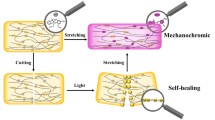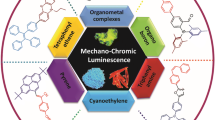Abstract
The incorporation of mechanophores, motifs that transform mechanical stimulus into chemical reaction or optical variation, allows creating materials with stress-responsive properties. The most widely used mechanophore generally features a weak bond, but its cleavage is typical an irreversible process. Here, we showed that this problem can be solved by folding—unfolding of a molecular tweezer. We systematically studied the mechanochromic properties of polyurethanes with cyano-substituted oligo(p-phenylene) vinylene (COP) tweezer (DPU). As a control experiment, a class of polyurethanes containing only a single COP moiety (MPU) was also prepared. The DPU showed prominent mechanochromic properties, due to the intramolecular folding-unfolding of COP tweezer under mechanical stimulus. The process was efficient, reversible and optical detectable. However, due to the disability to form either intramolecular folding or intermolecular aggregation, the MPU sample was mechanical inert.
Similar content being viewed by others
References
Hu H, Ma Z Y, Jia X R. Reaction cascades in polymer mechanochemistry. Materials Chemistry Frontiers, 2020, 4(11): 3115–3129
Deneke N, Rencheck M L, Davis C S. An engineer’s introduction to mechanophores. Soft Matter, 2020, 16(27): 6230–6252
Ciardelli F, Ruggeri G, Pucci A. Dye-containing polymers: methods for preparation of mechanochromic materials. Chemical Society Reviews, 2013, 42(3): 857–870
Wiggins K M, Brantley J N, Bielawski C W. Methods for activating and characterizing mechanically responsive polymers. Chemical Society Reviews, 2013, 42(17): 7130–7147
Li J, Nagamani C, Moore J S. Polymer mechanochemistry: from destructive to productive. Accounts of Chemical Research, 2015, 48(8): 2181–2190
Zeng H, Leng J S, Gu J P, et al. A thermoviscoelastic model incorporated with uncoupled structural and stress relaxation mechanisms for amorphous shape memory polymers. Mechanics of Materials, 2018, 124: 18–25
Zeng H, Leng J S, Gu J P, et al. Modeling the strain rate-, hold time-, and temperature-dependent cyclic behaviors of amorphous shape memory polymers. Smart Materials and Structures, 2018, 27(7): 075050
Gu J P, Sun H Y, Fang C Q. A finite deformation constitutive model for thermally activated amorphous shape memory polymers. Journal of Intelligent Material Systems and Structures, 2015, 26(12): 1530–1538
Cai H, Li X, Yin K, et al. A comparative study on the degradation properties of Mg wire/poly(lactic acid) composite rods: influence of rod diameter. Journal of Materials Engineering and Performance, 2022, 31(11): 9019–9028
Karman M, Verde-Sesto E, Weder C. Mechanochemical activation of polymer-embedded photoluminescent benzoxazole moieties. ACS Macro Letters, 2018, 7(8): 1028–1033
McFadden M E, Robb M J. Force-dependent multicolor mechanochromism from a single mechanophore. Journal of the American Chemical Society, 2019, 141(29): 11388–11392
Chen H, Yang F Y, Chen Q, et al. A novel design of multi-mechanoresponsive and mechanically strong hydrogels. Advanced Materials, 2017, 29(21): 1606900
Jia Y, Wang S, Wang W J, et al. Design and synthesis of a well-controlled mechanoluminescent polymer system based on fluorescence resonance energy transfer with spiropyran as a force-activated acceptor and nitrobenzoxadiazole as a fluorescent donor. Macromolecules, 2019, 52(20): 7920–7928
Lin Y J, Barbee M H, Chang C C, et al. Regiochemical effects on mechanophore activation in bulk materials. Journal of the American Chemical Society, 2018, 140(46): 15969–15975
Sulkanen A R, Sung J, Robb M J, et al. Spatially selective and density-controlled activation of interfacial mechanophores. Journal of the American Chemical Society, 2019, 141(9): 4080–4085
Wang T S, Zhang N, Dai J W, et al. Novel reversible mechanochromic elastomer with high sensitivity: bond scission and bending-induced multicolor switching. ACS Applied Materials & Interfaces, 2017, 9(13): 11874–11881
Wang T S, Wang H X, Shen L, et al. Force-induced strengthening of a mechanochromic polymer based on a naphthalene-fused cyclobutane mechanophore. Chemical Communications, 2021, 57(94): 12675–12678
Cawley P. Structural health monitoring: closing the gap between research and industrial deployment. Structural Health Monitoring, 2018, 17(5): 1225–1244
Raisch M, Genovese D, Zaccheroni N, et al. Highly sensitive, anisotropic, and reversible stress/strain sensors from mechanochromic nanofiber composites. Advanced Materials, 2018, 30(39): 1802813
Karman M, Verde-Sesto E, Weder C, et al. Mechanochemical fluorescence switching in polymers containing dithiomaleimide moieties. ACS Macro Letters, 2018, 7(9): 1099–1104
Willis-Fox N, Rognin E, Aljohani T A, et al. Polymer mechanochemistry: manufacturing is now a force to be reckoned with. Chem, 2018, 4(11): 2499–2537
Vidavsky Y, Yang S J, Abel B A, et al. Enabling room-temperature mechanochromic activation in a glassy polymer: synthesis and characterization of spiropyran polycarbonate. Journal of the American Chemical Society, 2019, 141(25): 10060–10067
Kabb C P, Obryan C S, Morley C D, et al. Anthracene-based mechanophores for compression-activated fluorescence in polymeric networks. Chemical Science, 2019, 10(33): 7702–7708
Magrini T, Kiebala D, Grimm D, et al. Tough bioinspired composites that self-report damage. ACS Applied Materials & Interfaces, 2021, 13(23): 27481–27490
Kim T A, Lamuta C, Kim H, et al. Interfacial force-focusing effect in mechanophore-linked nanocomposites. Advancement of Science, 2020, 7: 1903464
Seshimo K, Sakai H, Watabe T, et al. Segmented polyurethane elastomers with mechanochromic and self-strengthening functions. Angewandte Chemie, 2021, 133(15): 8487–8490
Pan Y F, Zhang H, Xu P X, et al. A mechanochemical reaction cascade for controlling load-strengthening of a mechanochromic polymer. Angewandte Chemie International Edition, 2020, 59(49): 21980–21985
Rohde R C, Basu A, Okello L B, et al. Mechanochromic composite elastomers for additive manufacturing and low strain mechanophore activation. Polymer Chemistry, 2019, 10(44): 5985–5991
Wu M J, Guo Z, He W Y, et al. Empowering self-reporting polymer blends with orthogonal optical properties responsive in a broader force range. Chemical Science, 2021, 12(4): 1245–1250
Chen Y J, Yeh C J, Guo Q, et al. Fast reversible isomerization of merocyanine as a tool to quantify stress history in elastomers. Chemical Science, 2021, 12(5): 1693–1701
Yang J H, Horst M, Werby S H, et al. Bicyclohexene-perinaphthalenes: scalable synthesis, diverse functionalization, efficient polymerization, and facile mechanoactivation of their polymers. Journal of the American Chemical Society, 2020, 142(34): 14619–14626
Imato K, Yamanaka R, Nakajima H, et al. Fluorescent supramolecular mechanophores based on charge-transfer interactions. Chemical Communications, 2020, 56(57): 7937–7940
Zhang Y X, Ren B P, Yang F Y, et al. Micellar-incorporated hydrogels with highly tough, mechanoresponsive, and self-recovery properties for strain-induced color sensors. Journal of Materials Chemistry C: Materials for Optical and Electronic Devices, 2018, 6(43): 11536–11551
Versaw B A, Mcfadden M E, Husic C C, et al. Designing naphthopyran mechanophores with tunable mechanochromic behavior. Chemical Science, 2020, 11(17): 4525–4530
Kim T A, Robb M J, Moore J S, et al. Mechanical reactivity of two different spiropyran mechanophores in polydimethylsiloxane. Macromolecules, 2018, 51(22): 9177–9183
Qiu W L, Gurr P A, Qiao G G. Regulating color activation energy of mechanophore-linked multinetwork elastomers. Macromolecules, 2020, 53(10): 4090–4098
Lee J P, Hwang H, Chae S, et al. A reversibly mechanochromic conjugated polymer. Chemical Communications, 2019, 55(63): 9395–9398
Calvino C, Guha A, Weder C, et al. Self-calibrating mechanochromic fluorescent polymers based on encapsulated excimer-forming dyes. Advanced Materials, 2018, 30(19): 1704603
Calvino C, Sagara Y, Buclin V, et al. Mechanoresponsive, luminescent polymer blends based on an excimer-forming telechelic macromolecule. Macromolecular Rapid Communications, 2019, 40(1): 1800705
Pucci A, Di Cuia F, Signori F, et al. Bis(benzoxazolyl)stilbene excimers as temperature and deformation sensors for biodegradable poly(1,4-butylene succinate) films. Journal of Materials Chemistry, 2007, 17(8): 783–790
Crenshaw B R, Weder C. Self-assessing photoluminescent polyurethanes. Macromolecules, 2006, 39(26): 9581–9589
Sagara Y, Karman M, Verde-Sesto E, et al. Rotaxanes as mechanochromic fluorescent force transducers in polymers. Journal of the American Chemical Society, 2018, 140(5): 1584–1587
Sagara Y, Karman M, Seki A, et al. Rotaxane-based mechanophores enable polymers with mechanically switchable white photoluminescence. ACS Central Science, 2019, 5(5): 874–881
Muramatsu T, Sagara Y, Traeger H, et al. Mechanoresponsive behavior of a polymer-embedded red-light emitting rotaxane mechanophore. ACS Applied Materials & Interfaces, 2019, 11(27): 24571–24576
Sagara Y, Traeger H, Li J, et al. Mechanically responsive luminescent polymers based on supramolecular cyclophane mechanophores. Journal of the American Chemical Society, 2021, 143(14): 5519–5525
Chen J, Ziegler A W, Zhao B M, et al. Chemomechanical-force-induced folding-unfolding directly controls distinct fluorescence dual-color switching. Chemical Communications, 2017, 53(36): 4993–4996
Traeger H, Sagara Y, Kiebala D J, et al. Folded perylene diimide loops as mechanoresponsive motifs. Angewandte Chemie International Edition, 2021, 60(29): 16191–16199
Acknowledgements
This work was financially supported by the National Natural Science Foundation of China (Grant Nos. 52103141 and 51803090) and the Natural Science Foundation of Jiangsu Province (Grant Nos. BK20181025 and BK20191022) for financial support.
Author information
Authors and Affiliations
Corresponding author
Additional information
Disclosure of potential conflicts of interest
The authors declare that they have no conflict of interest.
Rights and permissions
About this article
Cite this article
Zhang, N., Ma, XY., Li, S. et al. Mechanochromism of polyurethane based on folding—unfolding of cyano-substituted oligo(p-phenylene) vinylene dimer. Front. Mater. Sci. 17, 230640 (2023). https://doi.org/10.1007/s11706-023-0640-1
Received:
Accepted:
Published:
DOI: https://doi.org/10.1007/s11706-023-0640-1




